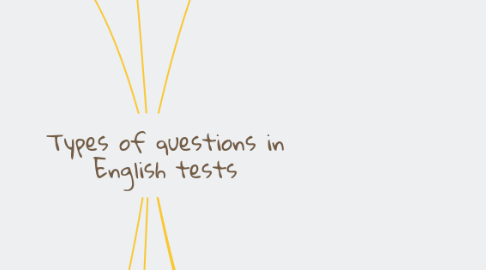
1. Transformation
1.1. Meaning
1.1.1. Note:
1.1.2. This type of question is about that the candidate has to rewrite a sentence based on an instruction or a key word given
1.1.3. . This type of task is fairly easy to mark, but the problem is that it doesn't test understanding. A candidate may simply be able to rewrite sentences to a formula.
1.1.3.1. Example:
1.1.3.1.1. Uses:
1.1.3.1.2. particularly effective for testing grammar and understanding of form. This wouldn't be an appropriate question type if you wanted to test skills such as reading or listening
1.1.3.2. Complete the second sentence so that it has the same meaning as the first. 'Do you know what the time is, John?' asked Dave. Dave asked John __________ (what) _______________ it was
2. Gap-filling
2.1. Meaning:
2.1.1. Example:
2.1.2. Check the exchange ______________ to see how much your money is worth.
2.1.2.1. Uses:
2.1.2.2. Gap-fills can be used to test a variety of areas such as vocabulary, grammar and are very effective at testing listening for specific words
2.1.3. A gap-fill is a practice exercise in which learners have to replace words missing with another appropriate word
3. Matching
3.1. Meanung
3.1.1. Example:
3.1.2. Match the word on the left to the word with the opposite meaning.: fat old young tall dangerous thin short safe
3.1.2.1. Uses:
3.1.2.2. Matching exercises are most often used to test vocabulary
3.2. With this question type, the candidate must link items from the first column to items in the second
4. Error Correction
4.1. Meaning
4.2. In this type of question the errors must be found and corrected in a sentence or passage. It could be an extra word, mistakes with verb forms, words missed etc. One problem with this question type is that some errors can be corrected in more than one way
4.2.1. Example:
4.2.1.1. Uses:
4.2.1.2. Error correction is useful for testing grammar and vocabulary as well as readings and listening.
4.2.2. Find the mistakes in the sentence and correct them. Ipswich Town was the more better team on the night.
5. Multiple choice
5.1. Meaning
5.2. a question type where the respondent is asked to choose one or more items from a limited list of choices.
5.2.1. A stem
5.2.2. Distractors
5.2.3. The correct answer
5.2.4. A multiple-choice question consists of three elements:
5.2.4.1. Example:
5.2.4.2. Cook is ________________today for being one of Britain's most famous explorers. a) recommended b) reminded c) recognised d) remembered
5.2.4.2.1. Uses:
5.2.4.2.2. Multiple choice can be used to test most things such as grammar, vocabulary, reading, listening etc. but you must remember that it is still possible for students to just 'guess' without knowing the correct answer
6. True / False
6.1. Meaning
6.2. The meaning of this questions is that the candidate must decide if a statement is true or false. Again this type is easy to mark but guessing can result in many correct answers. The best way to counteract this effect is to have a lot of items.
6.2.1. Example:
6.2.2. England won the world cup in 1966. T/F
6.2.2.1. Uses:
6.2.2.2. This question type is mostly used to test listening and reading comprehension
7. Open questions
7.1. Meanig
7.1.1. In this kind f question the candidate must answer simple questions after a reading or listening or as part of an oral interview. It can be used to test anything. If the answer is open-ended it will be more difficult and time consuming to mark and there may also be a an element of subjectivity involved in judging how 'complete' the answer is, but it may also be a more accurate test.
7.1.1.1. Example:
7.1.1.2. Answer the questions. Why did John steal the money?
7.1.1.2.1. Uses:
7.1.1.2.2. These question types are very useful for testing any of the four skills, but less useful for testing grammar or vocabulary

